Special Report
Largest Industry in Each State

Published:
Last Updated:

Dozens of industries across all 50 states comprise the U.S. economy — the world’s largest economy accounts for more than a quarter of global GDP. Several states, including California and New York, generate more output than several countries, including Belgium, Poland, and Turkey. Texas’s largest industry alone produces more in economic output than the entire economies of 19 states.
Real estate is by far the largest industry in the United States and the largest contributor to the economy in most states. But since housing is a universal need irrespective of geography, it fails to illuminate regional economic differences. Apart from real estate, economic value is created in a variety of ways across the country. In order to capture the unique economic features of each state, 24/7 Wall St. reviewed the largest industry in each state by GDP contribution — excluding real estate.
Click here to see the largest industry in each state.
Gross domestic product (GDP) is the estimated value of the goods and services produced by a nation’s economy. This figure can also be calculated for regions and for industries. Income from an industry is earned by owners of capital through interest, rent, and profit, as well as by workers through wages.
Martin Kohli, a senior regional economist with the Bureau of Labor Statistics, explained in an interview that because the GDP — or economic output — of an industry reflects incomes earned by these individuals, a state’s largest industry is almost always relatively high paying. Though many people work in retail trade, for example, “you don’t see retail trade as the largest industry in any state.”
The average annual salary of workers in the United States is $48,320. In the largest industry of 38 states, the average annual salary is higher. Workers in these industries also tend to earn more than the national average salary for that industry.
Subsectors of the health care industry dominate the economies of 17 states. In nine states, hospitals and nursing homes is the largest industry, and in another eight states, the ambulatory health care services sector comprises the largest share of total GDP.
Many of these states, including Florida, Maine, and Vermont, are home to especially high shares of residents 65 and older. Since the elderly typically require more frequent medical care than younger adults, the health care industry will likely only expand in the coming years as the baby boom generation continues to age. The BLS projects employment in the health care and social assistance industry to increase by at least 20% over the next decade, well above the average projected growth rate.
To identify the largest industry in each state, 24/7 Wall St. reviewed each state’s industries and their respective GDP contributions from the Bureau of Economic Analysis. All BEA data is as of 2014, the most recent period for which data is available. With only a few exceptions, the largest industry in each state is real estate. In order to identify regional industrial differences, we excluded the real estate sector in our examination. Employment and wage figures for private employees in each industry came from the Quarterly Census of Employment and Wages (QCEW). The QCEW and BEA industry data were aligned according to their NAICS codes.
These are the largest industries in each state.

1. Alabama
> Largest industry: Ambulatory health care services
> Industry GDP contribution: $7.63 billion
> Industry output as pct. of GDP: 4.2%
> Industry private workforce: 90,476
Alabama’s ambulatory health care services industry generates $7.6 billion annually, more than any other industry in the state. The large economic contribution is reflected by relatively high numbers of workers in the sector. While the 5.9% of the state’s workforce employed in the industry is in line with the national share, it is well above that of other industries in the state. Alabama has a relatively old population, with 15.7% of residents 65 and older. By contrast, 14.9% of the U.S. population is 65 or older. This likely drives up demand for such health services.
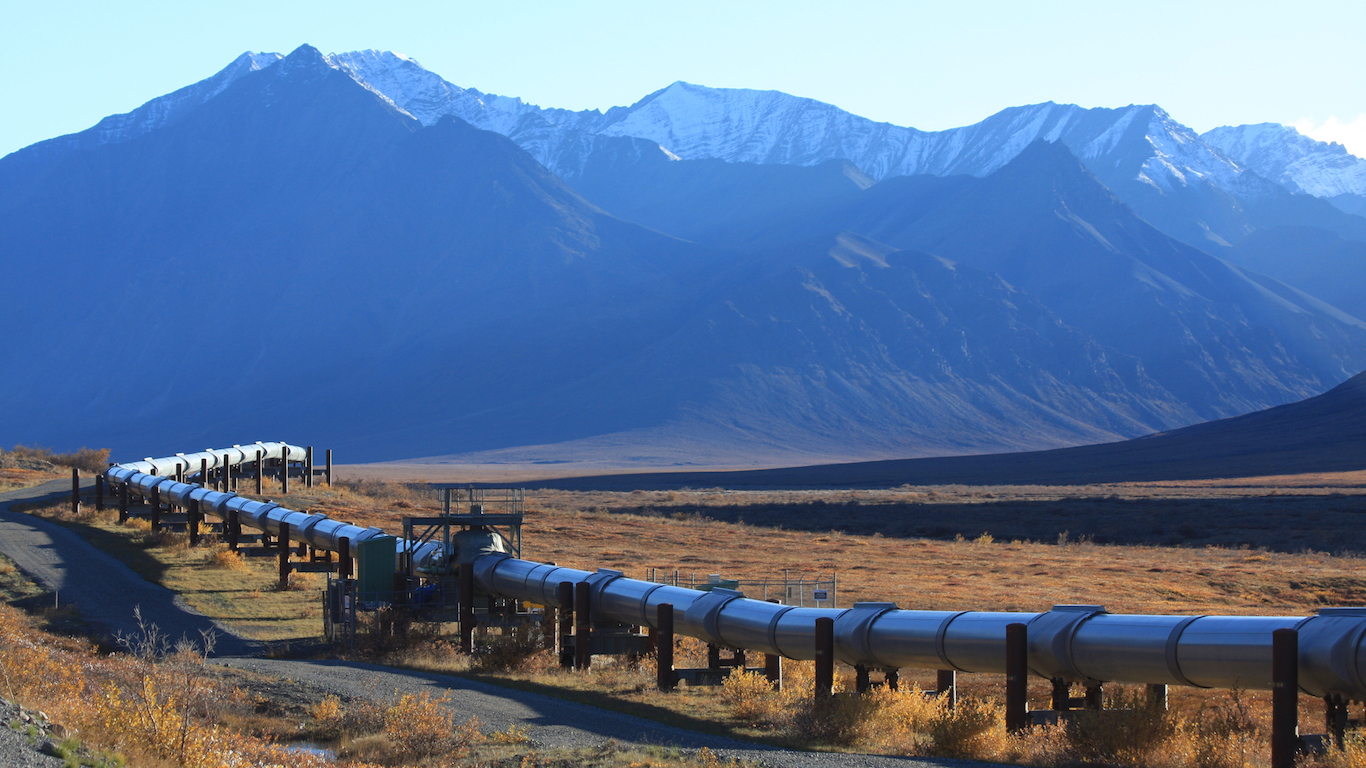
2. Alaska
> Largest industry: Oil and gas extraction
> Industry GDP contribution: $8.37 billion
> Industry output as pct. of GDP: 16.9%
> Industry private workforce: 4,091
Rich in resources and home to many of the nation’s largest oil fields, Alaska extracts more natural gas than all but two other states. The oil and gas extraction industry accounts for roughly $8.4 billion of the state’s GDP, more than any other industry. High salaries among industry workers also partially reflect the industry’s outsized economic contribution. Workers in oil and gas extraction earn an average of $222,304 a year, roughly $60,000 more than the average industry salary nationwide.

3. Arizona
> Largest industry: Ambulatory health care services
> Industry GDP contribution: $11.94 billion
> Industry output as pct. of GDP: 4.6%
> Industry private workforce: 145,882
Elderly Americans typically require more frequent doctor visits than younger Americans. In Arizona, 16.4% of the population is 65 and older, a larger share than in all but eight other states. With a larger than average elderly population, the ambulatory health care services industry contributes more to the state economy than any other industry.
Across the country, the health care industry is expanding as the baby boom generation ages. In Arizona, ambulatory health care services generates $11.94 billion in economic output, up 1.4% from the previous year.

4. Arkansas
> Largest industry: Broadcasting and telecommunications
> Industry GDP contribution: $5.66 billion
> Industry output as pct. of GDP: 5.1%
> Industry private workforce: 7,210
Just 7,120 people, or less than 1% of Arkansas’s workforce, are employed in broadcasting and telecommunications. However, the industry’s contribution to the state’s GDP of $5.7 billion is greater than that of any other industry in the state. The average annual salary among industry workers of $64,447, while lower than the national average for the industry, is a very good wage compared with other workers in Arkansas.
One of the larger U.S. wireless telecommunication companies, Alltel Corp. is based in Little Rock. The company, which AT&T acquired for $780 million in 2013, is one of the largest employers in the state.


6. Colorado
> Largest industry: Broadcasting and telecommunications
> Industry GDP contribution: $15.61 billion
> Industry output as pct. of GDP: 5.6%
> Industry private workforce: 33,966
Broadcasting and telecommunications is a $15.6 billion industry in Colorado, accounting for 5.6% of the state’s total GDP. Broadcasting and telecommunications’ outsized impact on the economy may be attributable to the presence of industry leaders. Headquartered just outside of Denver, broadcast giant DISH Network reported $15.1 billion in revenue in 2015. Other companies in the industry, including Verizon Wireless and Comcast, are also major employers in the state.

7. Connecticut
> Largest industry: Insurance carriers and related activities
> Industry GDP contribution: $15.78 billion
> Industry output as pct. of GDP: 6.9%
> Industry private workforce: 57,031
The economic output of Connecticut’s insurance industry actually declined slightly in 2014. Still, the income generated by the industry — its companies, workers, and properties — of $15.8 billion is greater than that of any other industry in the state. A state’s largest industry is almost never a low-paying industry, and the insurance industry pays very high wages, especially in Connecticut. The typical insurance worker in the state earns $129,107 annually, well above the average salary of $81,146 for insurance workers nationwide.
Connecticut is home to some of the nation’s largest insurance companies, including The Hartford, Aetna, and Travelers.

8. Delaware
> Largest industry: Insurance carriers and related activities
> Industry GDP contribution: $7.27 billion
> Industry output as pct. of GDP: 12.4%
> Industry private workforce: 6,250
The insurance industry contributes nearly $7.3 billion to total economic output in Delaware. The industry underwent a significant boom over the previous year, growing by 34.1%, the largest percentage increase in monetary output of any state’s largest industry. Due in part to the insurance industry’s increased economic output, banking is no longer the largest industry in Delaware. Despite an outsized economic contribution, the industry employs only 1.7% of the state’s workforce, roughly the same share of insurance industry workers in the American workforce.

9. Florida
> Largest industry: Ambulatory health care services
> Industry GDP contribution: $36.67 billion
> Industry output as pct. of GDP: 4.8%
> Industry private workforce: 454,074
The dominance of Florida’s ambulatory health care services industry is due partially to the high share of elderly residents in the state, who are more likely to require medical services than younger Americans. Close to one in every five Florida residents are 65 or older, the highest share in the nation. The industry contributed $36.67 billion to the state’s economy, accounting for 4.8% of all economic output.

10. Georgia
> Largest industry: Broadcasting and telecommunications
> Industry GDP contribution: $20.44 billion
> Industry output as pct. of GDP: 4.7%
> Industry private workforce: 58,243
There has been an increasing number of film productions and television sets in Georgia in recent years. In 2008, the state offered 20%-30% in tax credits for productions with budgets of at least half a million dollars. Since then, more than 140 movies and television shows have been shot, at least partially, in Atlanta alone.
Thanks in part in part to tax incentives, broadcasting and telecommunications overtook banking as the state’s largest industry, contributing $20.4 billion to GDP.

11. Hawaii
> Largest industry: Accommodation
> Industry GDP contribution: $3.83 billion
> Industry output as pct. of GDP: 5.5%
> Industry private workforce: 39,171
Hawaii’s economy relies heavily on tourists visiting the scenic island chain. Therefore, it is certainly no surprise that the accommodation sector is the state’s largest industry, contributing $3.83 billion to the economy. While property owners make money by renting out accommodations, industry workers benefit as well. The typical worker in the state’s largest industry earns $46,737 annually, significantly higher than the average salary of $29,619 accommodation workers nationwide earn.

12. Idaho
> Largest industry: Computer and electronic products manufacturing
> Industry GDP contribution: $2.59 billion
> Industry output as pct. of GDP: 4.5%
> Industry private workforce: 11,885
According to the Idaho Department of Commerce, advanced manufacturing is thriving in the state, having grown by nearly 40% over the decade through 2014. Computer and electronic products manufacturing, part of advanced manufacturing, is the state’s largest industry. The industry contributes $2.59 billion to the state’s economy annually and has also grown in recent years — by 6.3% in 2014 alone.
The average salary of industry workers of $101,448 a year is slightly lower than the average for such workers nationwide. The share of the state’s workforce employed in the industry, at 2.2%, is more than double the national share.

13. Illinois
> Largest industry: Insurance carriers and related activities
> Industry GDP contribution: $27.74 billion
> Industry output as pct. of GDP: 4.1%
> Industry private workforce: 112,372
The insurance industry is the largest in Illinois in terms of economic output. It employs some 2.2% of the state’s workforce and contributes 4.1% to total GDP. The industry’s economic impact is due largely to the presence of some industry giants in the state. Headquartered in Bloomington, one of the country’s largest insurance companies — State Farm — reported $75.7 billion in revenue in 2015. The average salary among insurance employees in Illinois is $88,653 a year, about $7,500 more than the average salary of industry workers nationwide.
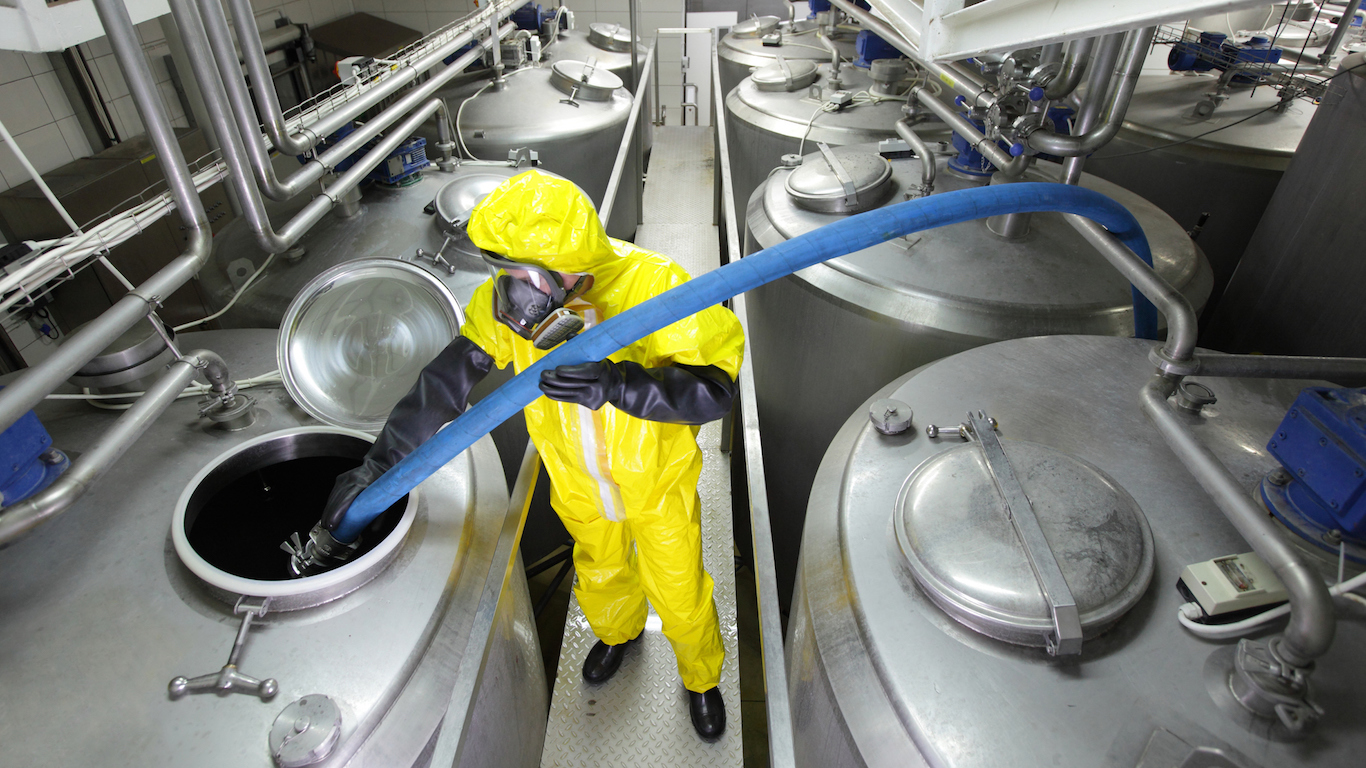
14. Indiana
> Largest industry: Chemical products manufacturing
> Industry GDP contribution: $24.02 billion
> Industry output as pct. of GDP: 8.2%
> Industry private workforce: 30,957
Unlike the largest industry in most states, Indiana’s chemical products manufacturing industry contracted slightly in 2014. Still, the sector contributes $24.02 billion to the state’s economy, more than any other industry in Indiana. With the industry employing around 31,000 Indiana residents, or 1.2% of the workforce, Indiana workers are nearly twice as likely to work in chemical products manufacturing as workers nationwide. Industry workers are also relatively well paid in the state, with a typical worker earning $107,385 a year. By contrast, the average salary of such workers nationally is $95,967.

15. Iowa
> Largest industry: Insurance carriers and related activities
> Industry GDP contribution: $11.37 billion
> Industry output as pct. of GDP: 7.4%
> Industry private workforce: 42,603
Iowa is one of six states where the insurance industry tops all others in terms of economic output. The industry contributes nearly $11.4 billion to the state’s economy, or roughly 7.4% of total GDP.
The industry has also played a significant historical role in the state. As commerce spread down the Mississippi River in the 19th century, insurance companies out of Iowa protected merchants and their inventory. Today, more than 80 insurance companies are headquartered in Iowa.

16. Kansas
> Largest industry: Broadcasting and telecommunications
> Industry GDP contribution: $5.12 billion
> Industry output as pct. of GDP: 3.9%
> Industry private workforce: 10,945
The broadcasting and telecommunications industry expanded by 3.0% over in 2014, overtaking hospitals, nursing, and residential care facilities as the largest industry in state. Broadcasting and telecommunications now contributes more than $5 billion to Kansas’s total GDP.
The industry’s outsized contribution to economic output is due in part to the presence of certain industry giants. Telecom company Sprint, headquartered in Overland Park right outside of Kansas City, reported $32.2 billion in revenue in its fiscal 2015.

17. Kentucky
> Largest industry: Food and beverage and tobacco products manufacturing
> Industry GDP contribution: $6.61 billion
> Industry output as pct. of GDP: 3.9%
> Industry private workforce: 33,519
A state’s largest industry does not tend to change from one year to the next. Kentucky is one of a few states, however, where the largest industry has changed. Last year, the state’s motor vehicles and parts manufacturing was the largest industry. Now, the food and beverage and tobacco products manufacturing sector, contributing $6.61 billion to the economy, is the largest.
KFC, Pizza Hut, and Taco Bell holding company Yum! Brands are based in the state. According to the Kentucky Cabinet for Economic Development, the dominance and recent surge of the food and beverage industry is due largely to the state’s historically strong agricultural industry.

18. Louisiana
> Largest industry: Petroleum and coal products manufacturing
> Industry GDP contribution: $14.26 billion
> Industry output as pct. of GDP: 6.8%
> Industry private workforce: 12,060
Louisiana’s petroleum and coal products manufacturing industry grew by 26.1% in 2014, a massive growth for a single year. Just under 1% of the Louisiana workforce is employed in the industry, but that share is eight times greater than the comparable national percentage. A state’s largest industry is rarely a low paying one, and Louisiana’s petroleum and coal products manufacturing industry is no different. The typical petroleum and coal products worker in Louisiana earns $117,951 annually, slightly more than the salary of a typical industry worker nationwide of $113,937.

19. Maine
> Largest industry: Hospitals and nursing and residential care facilities
> Industry GDP contribution: $3.30 billion
> Industry output as pct. of GDP: 6.6%
> Industry private workforce: 56,460
With just over $50 billion in economic output, Maine’s economy is one of the smallest in the country. Of all industries in the state, hospitals, nursing, and residential care facilities contribute the most to overall GDP. The industry’s dominance may not be surprising, as 18.8% of the state’s population is 65 and older, the highest share in the country with the exception of Florida. The industry, which caters in large part to the elderly, contributes roughly 6.6% to Maine’s total GDP.

20. Maryland
> Largest industry: Ambulatory health care services
> Industry GDP contribution: $11.54 billion
> Industry output as pct. of GDP: 3.6%
> Industry private workforce: 132,215
Ambulatory health care services, also known as outpatient care, is the largest industry in Maryland based on economic output. The industry accounts for 3.6% of Maryland’s $322 billion economy. The ambulatory health care industry also provides jobs for 6.3% of the state’s total workforce.
The industry’s economic impact in the state is likely bolstered by the presence of Johns Hopkins Medicine. Headquartered in Baltimore, JHM operates a number of medical facilities statewide that also serve as training facilities for medical students from Johns Hopkins University.

21. Massachusetts
> Largest industry: Hospitals and nursing and residential care facilities
> Industry GDP contribution: $19.77 billion
> Industry output as pct. of GDP: 4.7%
> Industry private workforce: 293,585
Massachusetts is home to some of the nation’s largest and most prestigious hospitals and health institutions. For example, Massachusetts General, one of the Harvard Medical School’s teaching hospitals, is one of the largest and oldest hospitals in the nation and is widely regarded as among the best in New England, if not the country. The hospitals and nursing and residential care facilities sector contributed $19.77 billion to the state’s economy, more than any other industry. In line with its dominant role in the state’s economy, the industry employs close to one in 10 workers in Massachusetts, a relatively high share even compared with the largest industry in most other states.

22. Michigan
> Largest industry: Hospitals and nursing and residential care facilities
> Industry GDP contribution: $16.71 billion
> Industry output as pct. of GDP: 4.0%
> Industry private workforce: 302,715
For the first time in decades, Michigan’s largest industry is no longer even related to automobile manufacturing. The Big Three American automakers — General Motors, Ford Motor Company, and Fiat Chrysler Automobiles US — are all still based in Detroit, Michigan, but may soon reduce their contribution to the state’s industry. All three companies have recently announced plans to relocate small car manufacturing from the area to lower-cost regions like Mexico and the Southern United States.
Now, as is the case in a number of other states, hospitals and nursing and residential care facilities is the largest industry in Michigan, contributing $16.71 billion to the state economy.

23. Minnesota
> Largest industry: Ambulatory health care services
> Industry GDP contribution: $12.14 billion
> Industry output as pct. of GDP: 4.2%
> Industry private workforce: 141,603
The ambulatory health care services sector accounts for 4.2% of Minnesota’s GDP and employs 5.9% of the state’s workforce. Generating more than $12 billion in economic output, it is the largest industry in the state.
While the aging baby boom generation is leading to rapid expansion in the broader health care industry nationwide, the industry’s outsized presence in Minnesota is further bolstered by other factors. The world-renowned Mayo Clinic has a major campus in Rochester, Minnesota, The campus provides health care jobs and research fellowships to nearly 35,000 medical professionals and students.

24. Mississippi
> Largest industry: Ambulatory health care services
> Industry GDP contribution: $3.86 billion
> Industry output as pct. of GDP: 4.1%
> Industry private workforce: 47,051
The elderly need more frequent medical care than younger people. Consequently, the broader health care industry has been growing rapidly as the baby boom generation ages. Mississippi is one of eight states where ambulatory health care services is the largest industry. Outpatient care generates $3.9 billion in economic output a year, or roughly 4.1% of the state’s GDP. The state is home to several medical research facilities, and in 2012, the state legislature passed an incentive aimed at increasing the number of health care jobs and at expanding access to health care for state residents.

25. Missouri
> Largest industry: Hospitals and nursing and residential care facilities
> Industry GDP contribution: $10.72 billion
> Industry output as pct. of GDP: 4.2%
> Industry private workforce: 196,270
The hospitals, nursing, and residential care facilities sector in Missouri generates $10.7 billion in economic output annually. While demand for health care is increasing nationally as the baby boom generation ages, the industry is uniquely strong in Missouri. The state is home to six medical schools and several top ranked hospitals. As a result, the industry also provides jobs for 8.5% of the state’s workforce.

26. Montana
> Largest industry: Hospitals and nursing and residential care facilities
> Industry GDP contribution: $1.92 billion
> Industry output as pct. of GDP: 4.8%
> Industry private workforce: 35,009
Health-related industries are often among the largest contributors to state economies. With its hospitals and nursing industry contributing close to $2 billion to its economy, Montana is one such state. In old age, there is a greater risk of injury and certain health conditions, and older individuals tend to visit the doctor more often. In Montana, 17.3% of the population is 65 or older, the fifth highest share of all states. By contrast, 14.9% of residents nationwide are 65 or older. The high share of elderly residents may partially explain the dominance of the state’s largest industry.

27. Nebraska
> Largest industry: Farms
> Industry GDP contribution: $6.11 billion
> Industry output as pct. of GDP: 6.2%
> Industry private workforce: 11,473
Farms contribute more to Nebraska’s economy than any other industry. Producing more than $6 billion in output, farming accounts for 6.2% of GDP in the Cornhusker State. On a national scale, Nebraska ranks near the top in terms of agricultural exports. In 2015 alone, farms across the state slaughtered 6.6 million heads of cattle for commercial purposes, more than any other state. Additionally, farms across the state produced nearly 1.7 billion bushels of corn for grain production, trailing only two other states.

28. Nevada
> Largest industry: Accommodation
> Industry GDP contribution: $13.27 billion
> Industry output as pct. of GDP: 10.8%
> Industry private workforce: 195,061
Las Vegas, the largest city in Nevada, is iconic as a vacation destination for gambling and entertainment. Each year, the city attracts roughly 41 million visitors. Hosting all of these tourists contributes a great deal to the state economy. The accommodation industry alone accounts for more than a 10th of Nevada’s GDP. The industry also provides jobs for 17.8% of the state’s workforce.

New Hampshire is one of six states where insurance carriers and related activities is the largest industry. The industry contributes $3.3 billion to the state’s economic output, or 5.0% of total GDP. Notably, the state was the first in the country to establish an agency to regulate the industry and enact and enforce relevant laws. Still acting in the public interest today, the New Hampshire Insurance Department was founded in 1851.

30. New Jersey
> Largest industry: Ambulatory health care services
> Industry GDP contribution: $19.82 billion
> Industry output as pct. of GDP: 4.0%
> Industry private workforce: 222,257
The U.S. health care industry is huge and is projected to grow at a faster pace than the economy as a whole in coming years. New Jersey is one of eight states where ambulatory health care services contributes more to overall GDP than any other industry. Health care has been a critical industry for the state historically as well. It is the only industry in the Garden State to have added jobs every year from 1990 to 2013.
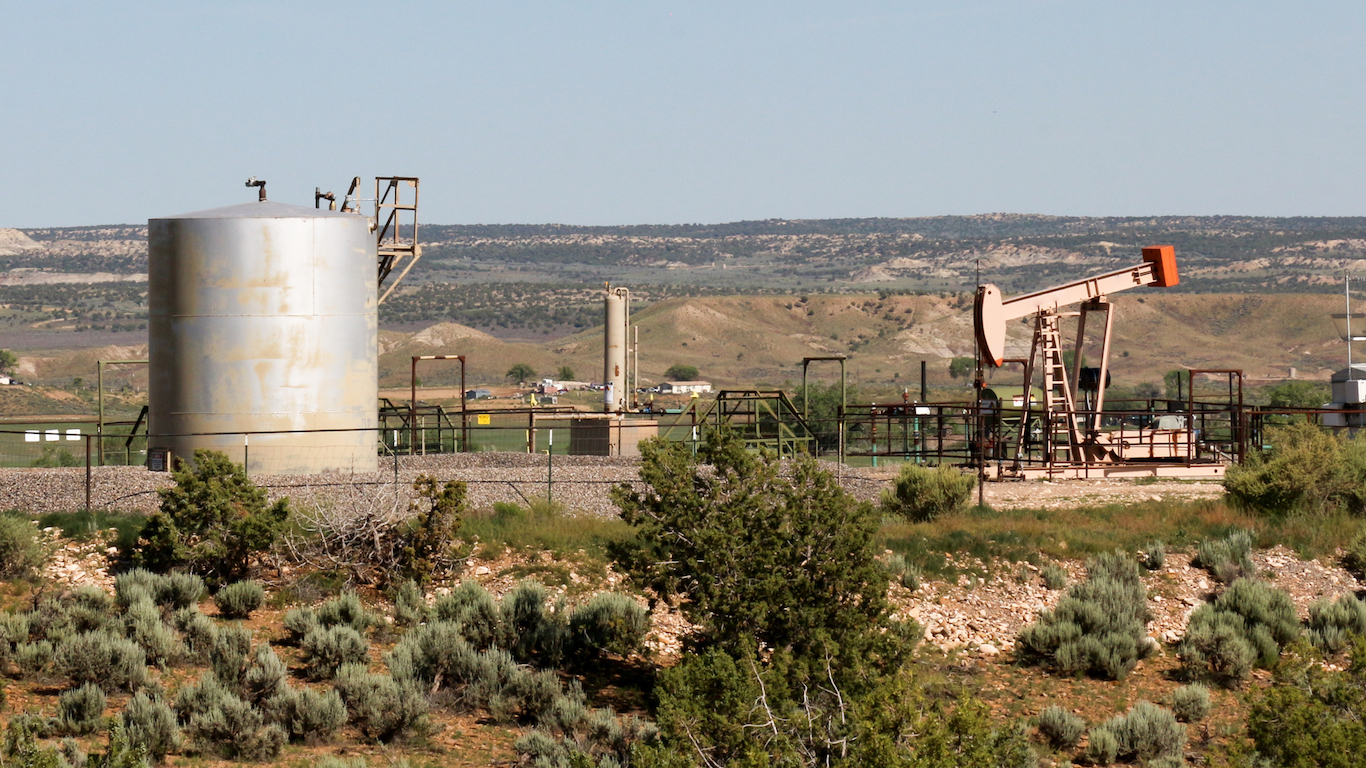
31. New Mexico
> Largest industry: Oil and gas extraction
> Industry GDP contribution: $6.09 billion
> Industry output as pct. of GDP: 7.1%
> Industry private workforce: 5,342
New Mexico is one of the nation’s major sources of coal, natural gas, and petroleum. With its more than 25,000 oil wells and some of the country’s largest oil fields, the resource-rich state produces 4% of the nation’s crude oil — according to the Energy Information Administration. The oil and gas extraction industry is the state’s largest, contributing $6.09 billion to New Mexico’s economy.
While in the majority of states, the largest industry is not especially low paying, the average oil and gas extraction salary in New Mexico of $100,829 a year is considerably lower than the national average for the industry of $161,934 a year.

New York’s $1.2 trillion economy is the third largest in the country, trailing only California and Texas. As a global banking and finance hub, New York City is the state’s major economic engine. Down from $98.1 billion the year prior, the banking industry now contributes $88.1 billion to the state’s total GDP. Despite the contraction, the industry remains the largest in the state.

33. North Carolina
> Largest industry: Chemical products manufacturing
> Industry GDP contribution: $22.62 billion
> Industry output as pct. of GDP: 5.3%
> Industry private workforce: 42,446
Chemical products manufacturing contributes more to North Carolina’s economy than any other industry. Several major companies in the industry have a footprint in the state. Industry giant Dow Chemical, a company that reported $49 billion in sales in 2015, has two locations in the state. Earlier this year, however, the company announced its intention to close its plant in Greensboro, affecting some 130 workers in the state.
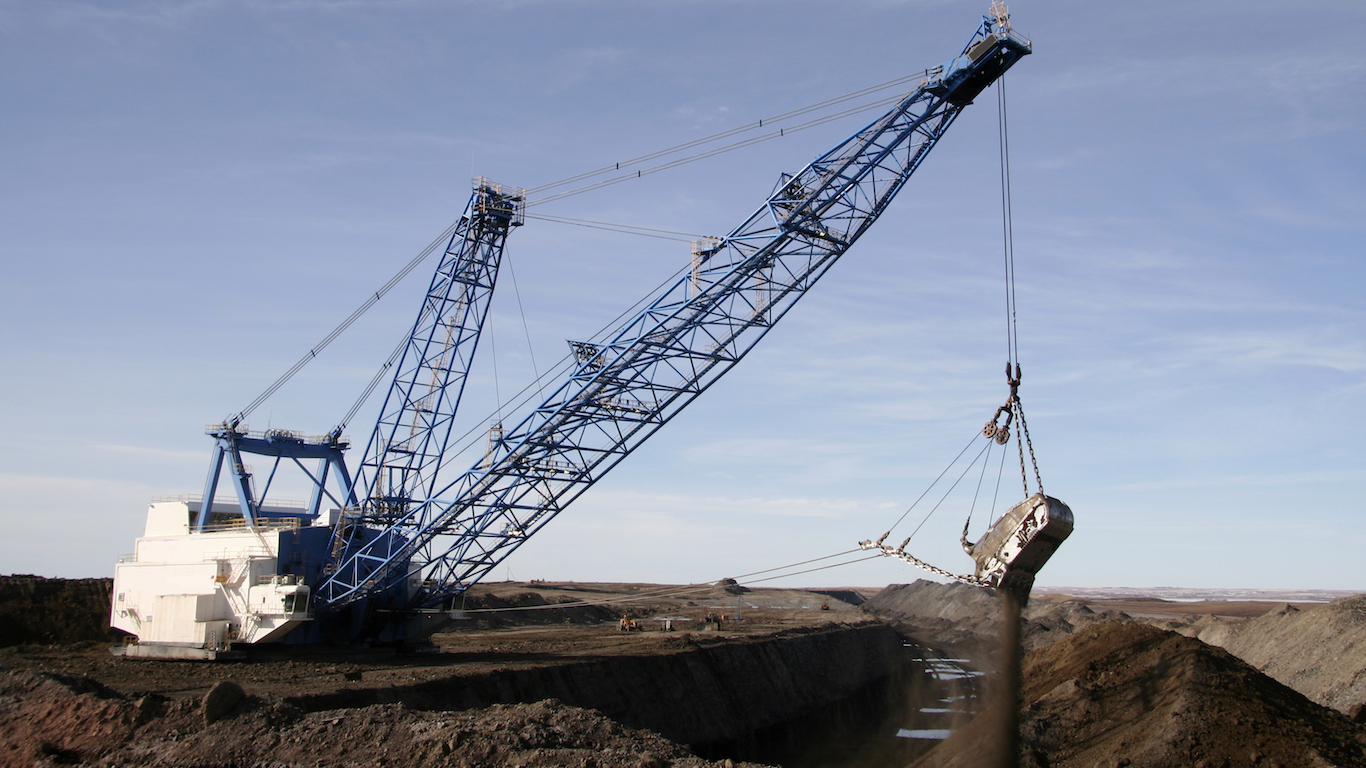
34. North Dakota
> Largest industry: Support activities for mining
> Industry GDP contribution: $4.88 billion
> Industry output as pct. of GDP: 9.5%
> Industry private workforce: 18,111
North Dakota’s population boom in the last five years is largely due to jobs related to resource extraction. In the resource-rich state, support activities for mining is a $4.9 billion industry, accounting for 9.5% of the state’s total economic output.
In the coming years, construction of the controversial Dakota Access Pipeline will likely further boost the industry. The pipeline will run over 1,000 miles, from the northwest corner of the state into existing infrastructure in Illinois, and carry roughly half a million barrels of oil a day.

35. Ohio
> Largest industry: Hospitals and nursing and residential care facilities
> Industry GDP contribution: $22.38 billion
> Industry output as pct. of GDP: 4.2%
> Industry private workforce: 415,374
Due largely to the aging baby boomers, the health care industry is one of the most rapidly growing in the country. In Ohio, the hospitals and nursing homes sector alone generates $22.4 billion in economic output annually and provides jobs to 9.1% of the state’s workforce. Hospitals, specifically, have been an economic savior for the state. Between 2000 and 2013, the number of jobs in Ohio dropped by 6.6%. Over the same time period, the number of jobs available in hospitals across the state increased by 26%.
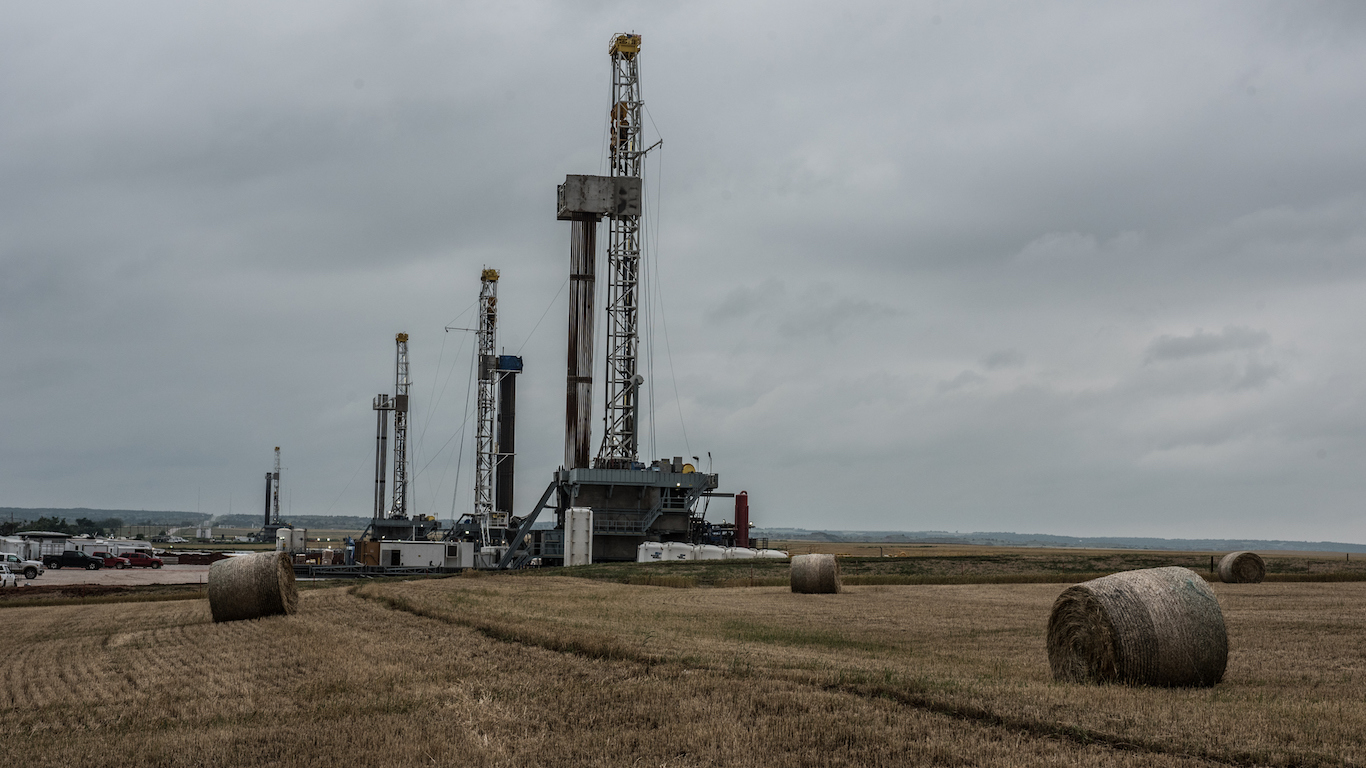
36. Oklahoma
> Largest industry: Oil and gas extraction
> Industry GDP contribution: $20.38 billion
> Industry output as pct. of GDP: 12.1%
> Industry private workforce: 23,868
One of the top five oil-producing states, Oklahoma’s biggest industry is oil and gas extraction. Though oil extraction has been a crucial component of Oklahoma’s history and economic development, it has had an increasingly large role in recent years, as the number of proved reserves in the state doubled between 2009 and 2014. Today, oil and gas extraction generates $20.4 billion in economic output annually, or more than a tenth of the state’s total GDP.

37. Oregon
> Largest industry: Computer and electronic products manufacturing
> Industry GDP contribution: $33.89 billion
> Industry output as pct. of GDP: 17.7%
> Industry private workforce: 37,520
Oregon’s largest industry, computer and electronic products manufacturing, accounts for 17.7% of the state’s GDP. Despite dropping by 5.4% in 2014, the sector makes up a larger share of total GDP than any industry in every other state. A state’s largest industry tends to be relatively high paying. This is especially the case in Oregon, where the typical computer and electronic products manufacturing worker earns $126,842 annually, considerably more than the national average industry salary of $108,870.
Computer chip manufacturer Intel is based in California, but several of its fabrication plants are located in Oregon. The plants employ tens of thousands of Oregon residents and contribute substantially to the state’s economy.

38. Pennsylvania
> Largest industry: Hospitals and nursing and residential care facilities
> Industry GDP contribution: $28.13 billion
> Industry output as pct. of GDP: 4.6%
> Industry private workforce: 471,908
Only five states have a larger share of elderly residents than Pennsylvania. The relatively large 17% share of 65 or older residents is the most likely explanation for the state’s largest industry. Hospitals and nursing homes generate $28.1 billion annually in the Keystone State, or nearly 5% of the state’s GDP. As the population ages, the industry will likely only expand in the coming years.

39. Rhode Island
> Largest industry: Hospitals and nursing and residential care facilities
> Industry GDP contribution: $2.76 billion
> Industry output as pct. of GDP: 5.5%
> Industry private workforce: 41,663
Though it is the smallest state geographically, Rhode Island has a larger economy than six other states. The industry contributing the most to the state’s $50.5 billion GDP is hospitals, nursing homes, and residential care facilities.
Historically, the industry has been a major component of the state economy, and that is not likely to change in the coming years. The broader health care industry was the fastest growing in the state between 2000 and 2010. Projections suggest the industry will be the largest employer in the state at least through 2020.

40. South Carolina
> Largest industry: Administrative and support services
> Industry GDP contribution: $6.81 billion
> Industry output as pct. of GDP: 3.9%
> Industry private workforce: 146,396
Workers in the administrative and support services sector are frequently employed as secretaries, administrative assistants, office clerks, as well as janitors and security guards. Such jobs are found across most segments of the economy. In South Carolina, the industry generates $6.81 billion, more than any other industry in the state.
South Carolina’s largest industry employs 9.1% of the state’s workforce, a relatively large share compared with the national percentage. However, the industry is exceptional on this list as the average worker earns just $30,021 — lower than the national average salary for workers in the industry and especially low compared with wages in the largest industries in other states.

According to the Federal Deposit Insurance Corporation, South Dakota bank assets are worth nearly $3 trillion, or roughly 18% of all bank assets in the United States. In addition, many major banks have their credit card headquarters in South Dakota because the state eliminated interest rate caps.
An unambiguously bank-friendly state, South Dakota’s largest industry is banking. Annual economic output from banking accounts for more than a tenth of the state’s total GDP.

42. Tennessee
> Largest industry: Ambulatory health care services
> Industry GDP contribution: $13.33 billion
> Industry output as pct. of GDP: 4.8%
> Industry private workforce: 144,014
Ambulatory health care services, or outpatient health care, is the largest industry by economic output in Tennessee. The industry contributes more than $13 billion to the state’s economy and employs more than 144,000 people statewide. In Nashville alone, the broader health care industry accounts for more than a quarter of all nonfarm employment.
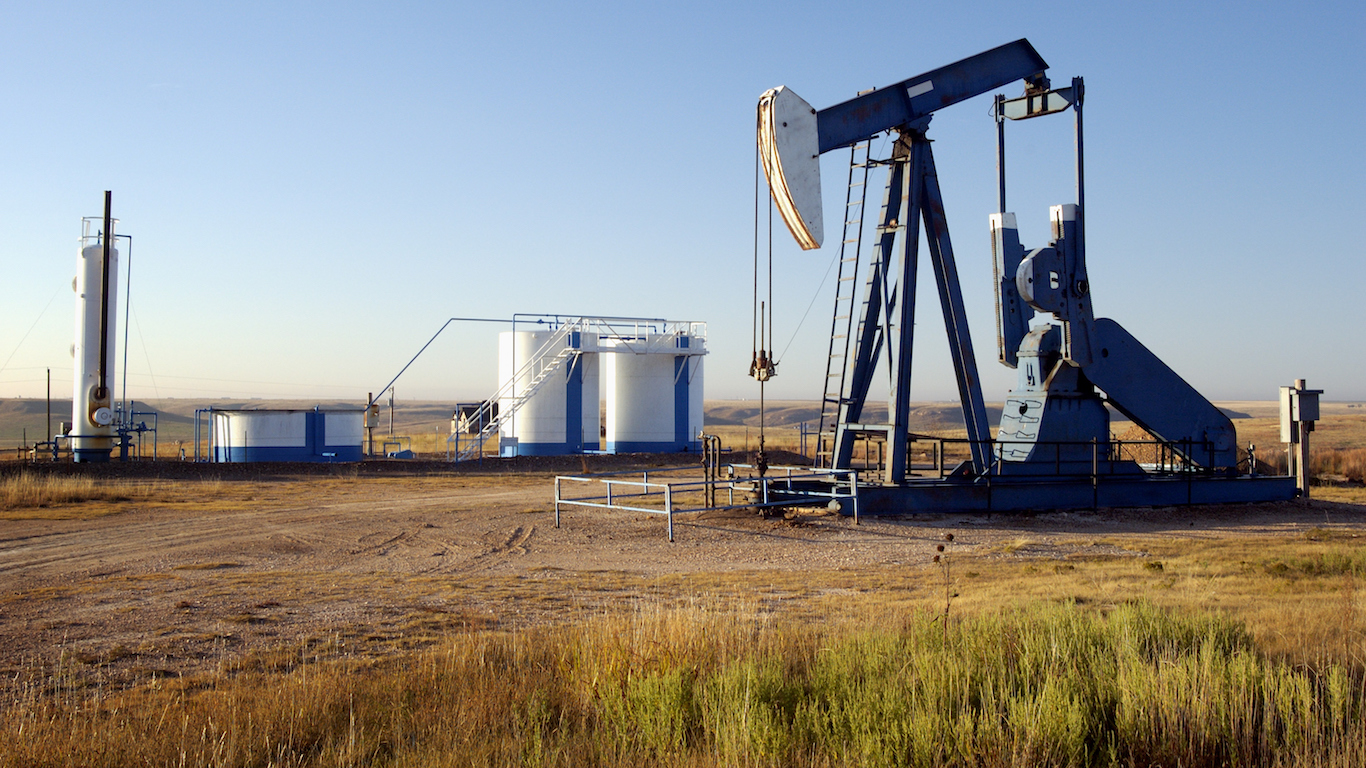
43. Texas
> Largest industry: Oil and gas extraction
> Industry GDP contribution: $127.18 billion
> Industry output as pct. of GDP: 8.9%
> Industry private workforce: 99,353
The Permian Basin in West Texas is home to 20 of the nation’s 100 largest oil fields. It is therefore not surprising that oil and gas extraction is the state’s largest industry, and that Texas is the nation’s largest oil producing state by a wide margin. The industry contributes $127.18 billion to the economy, dwarfing the economic output of any one industry in any state and the total GDPs of 19 states. Oil prices fell sharply in 2014, from well over $100 a barrel to a low as $30 a barrel in early 2016. While the drop certainly had an impact in Texas as it did elsewhere, the industry remains massive. Also, prices have risen so far this year, an encouraging development for industry workers in Texas.

44. Utah
> Largest industry: Federal Reserve banks, credit intermediation, and related services
> Industry GDP contribution: $5.84 billion
> Industry output as pct. of GDP: 4.6%
> Industry private workforce: 34,458
Utah’s banking industry, which is unique compared with banking in other states, contributes more to state GDP than any other industry. There are for example 15 industrial banks operating in the state. In Utah, these banks are not subject to the same regulatory oversight as other banks. Companies may seek an industrial bank charter to avoid the limitations of the Bank Holding Company Act or the Glass Steagall Act. Only a few states have these banks.
The banking industry’s economic output dropped to $5.8 billion from $6.1 billion in 2014. Although the industry shrank, Utah’s total GDP expanded by 2.2%. The industry also remains the largest in the state.

45. Vermont
> Largest industry: Hospitals and nursing and residential care facilities
> Industry GDP contribution: $1.25 billion
> Industry output as pct. of GDP: 4.6%
> Industry private workforce: 20,903
Health-related sectors are the largest industry in many states. With its hospitals and nursing industry contributing $1.25 billion to its economy, the health-related sector is also the largest in Vermont. In old age, there is a greater risk of injury and certain health conditions, and older individuals tend to visit the doctor more often. In Vermont, 17.6% of the population is 65 and older, the fourth highest percentage of any state.
Vermont’s unemployment rate, which has fallen each year since the end of the recession, continues to be among the lowest in the nation. The state’s health industry appears to provide a reliable source of relatively high-paying jobs. The industry employs more than 20,000 Vermonters, or 8.2% of the workforce. The typical industry worker in the state earns $49,270 annually, greater than the national average salary for the industry.

Despite contracting by 5.9% in 2014, food and beverage and tobacco products manufacturing is the largest industry in Virginia, generating nearly $15 billion for the economy.
Only a handful of states produce almost all of the nation’s tobacco, and Virginia is one of them. The state produced 52.4 million pounds of tobacco in 2015, a substantial portion of the U.S. total of 715.9 million pounds. While this was down from the previous year, it still trails only North Carolina and Kentucky, in tobacco production.

47. Washington
> Largest industry: Publishing industries, except Internet (includes software)
> Industry GDP contribution: $31.52 billion
> Industry output as pct. of GDP: 8.2%
> Industry private workforce: 61,912
The publishing industry is the largest in Washington, accounting for more than 8% of the state’s GDP. It is the only state in the country where publishing is the largest industry in the economy. While only 2.4% of the state’s workforce is employed in the publishing industry, the state is home to a far higher concentration of publishing jobs than the country as a whole. A state’s largest industry is almost never a low paying one, and publishing jobs in Washington are especially high paying. The typical publishing worker in the state earns $190,150, considerably more than the average for such workers nation, at $103,684.
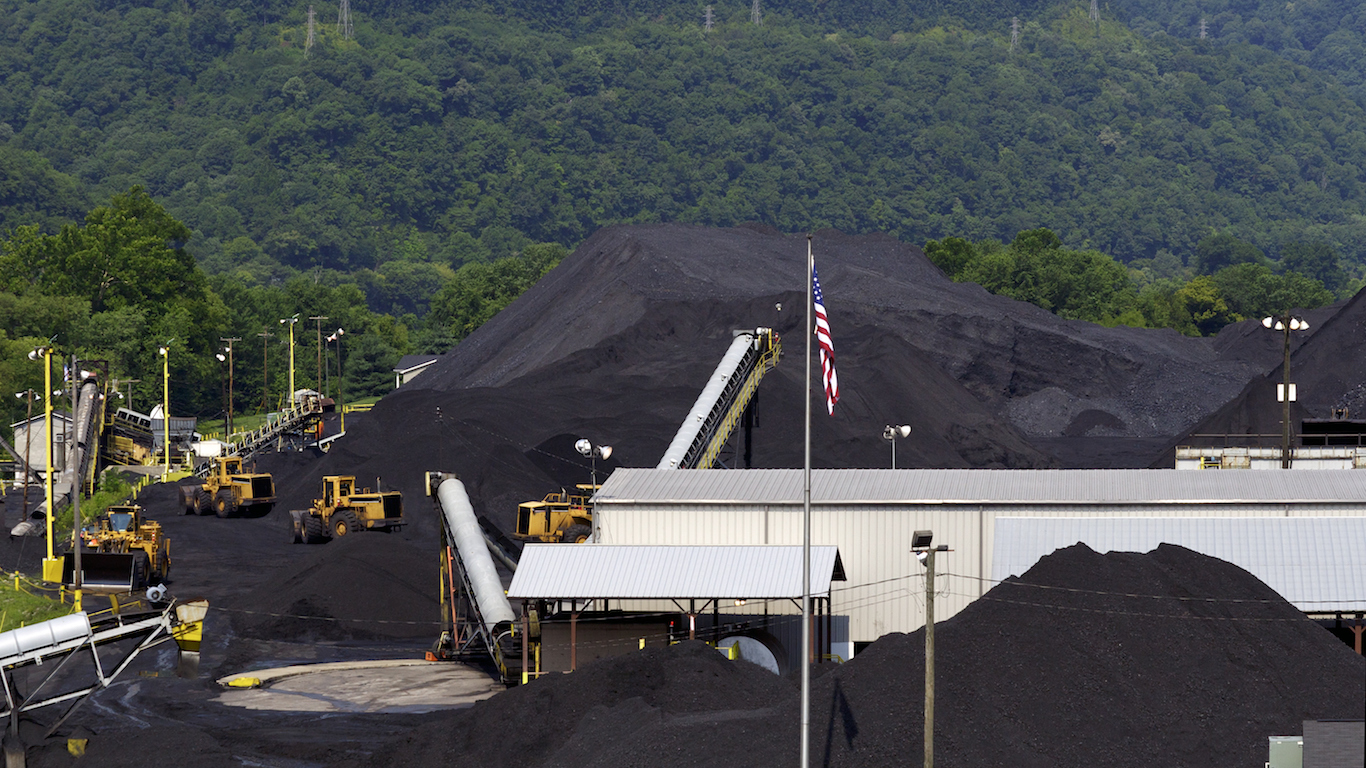
48. West Virginia
> Largest industry: Mining, except oil and gas
> Industry GDP contribution: $6.22 billion
> Industry output as pct. of GDP: 9.2%
> Industry private workforce: 16,526
The mining industry, which includes coal mining, is the biggest contributor to West Virginia’s economy. Producing more coal than any other state except for Wyoming, mining in West Virginia generates $6.2 billion in economic output, 9.2% of the state’s GDP.
Due in part to recent changes in laws and regulations such as the EPA’s Clean Power Plan, which requires reductions in carbon emissions, coal’s economic contribution to the nation and West Virginia’s economy will likely wane in coming years. Mining’s economic output in West Virginia dropped 3.6% in 2014.

49. Wisconsin
> Largest industry: Insurance carriers and related activities
> Industry GDP contribution: $12.76 billion
> Industry output as pct. of GDP: 4.7%
> Industry private workforce: 62,351
Wisconsin’s insurance industry expanded by 12.6% in 2014, far outpacing the state’s 2.1% total economic growth. The industry grew despite the slight contraction in the broader finance sector. Contributing nearly $12.8 billion to the state’s economy, insurance accounts for 4.7% of Wisconsin’s GDP. With a higher concentration of insurance industry workers than the country as a whole, the industry provides high paying jobs for 2.6% of the state’s workforce.
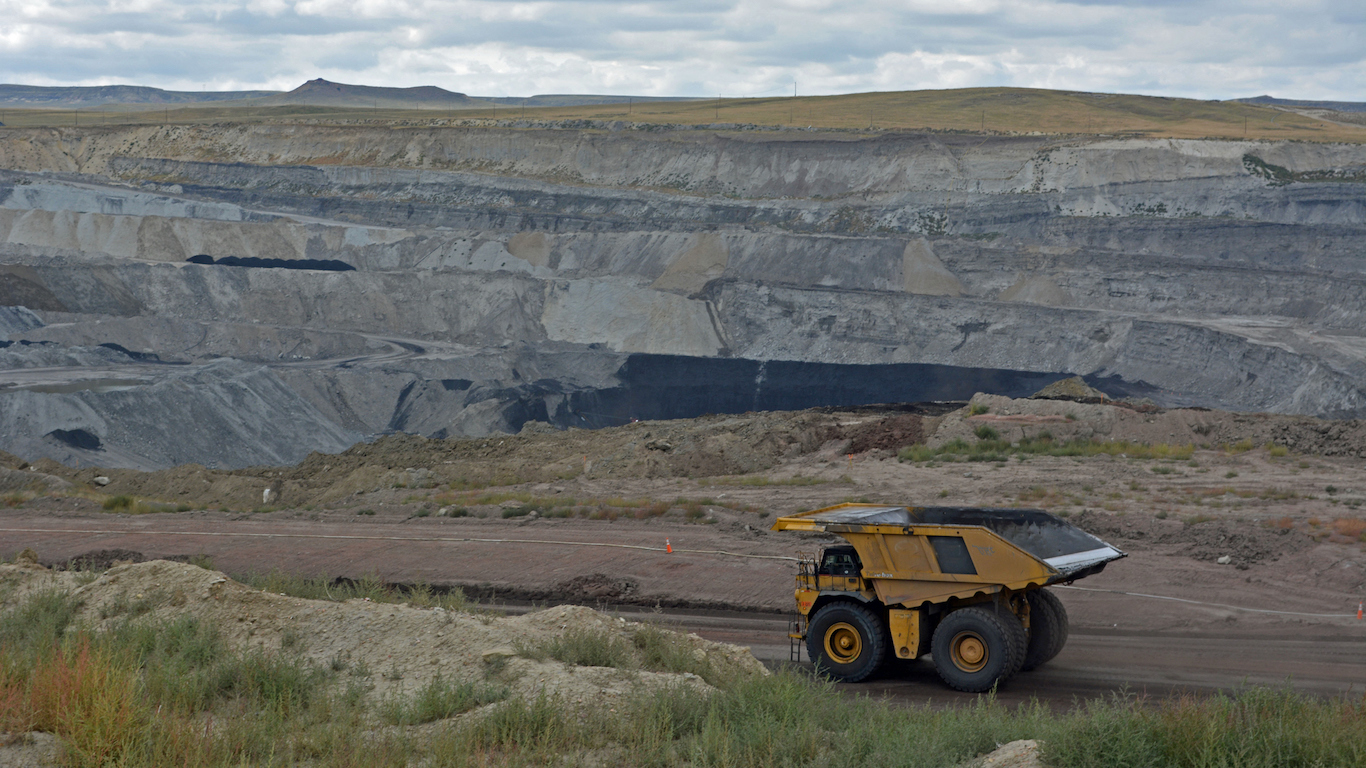
50. Wyoming
> Largest industry: Mining, except oil and gas
> Industry GDP contribution: $4.20 billion
> Industry output as pct. of GDP: 12.0%
> Industry private workforce: 9,458
Home to most of the nation’s largest coal mines, Wyoming produces 40% of all coal in the United States, the most of any state. The state is also home to the world’s largest deposit of trona, a mineral used in a process that helps coal-fired generators meet emission standards. Given Wyoming’s considerable natural resources, it is not surprising that mining is the largest industry in the state, accounting for 12% of economic output.
As the country shifts to cleaner energy sources, the short-term outlook of the coal industry, and consequently mining, in the state is not good — according to the Energy Information Administration. Already, coal’s economic output shrank by nearly 15% in 2014.
If you’re one of the over 4 Million Americans set to retire this year, you may want to pay attention. Many people have worked their whole lives preparing to retire without ever knowing the answer to the most important question: am I ahead, or behind on my goals?
Don’t make the same mistake. It’s an easy question to answer. A quick conversation with a financial advisor can help you unpack your savings, spending, and goals for your money. With Zoe Financial’s free matching tool, you can connect with trusted financial advisors in minutes.
Why wait? Click here to get started today!
Thank you for reading! Have some feedback for us?
Contact the 24/7 Wall St. editorial team.